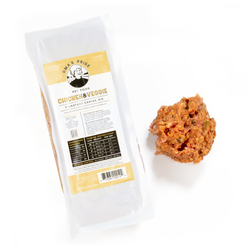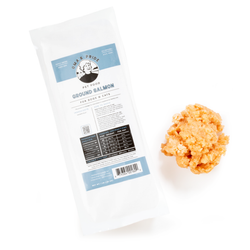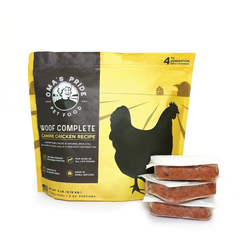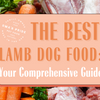11 Myths Versus Facts: Raw Food For Dogs & Cats
Table of contents
- Raw food diets are too dangerous because of bacteria
- My pet will get sick eating raw meat because it contains parasites
- Pets are not wild animals, so they need cooked food and carbs, not raw meat
- My pet will become bloodthirsty and aggressive if they eat raw meat
- Dogs and cats can't eat kibble and raw food at the same time
- Feeding my pet raw food will make me sick
- Cooked food or kibble is better than raw food for pets
- Puppies and kittens can't eat raw food
- Raw bones are dangerous for pets because they splinter
- Raw feeding is too complicated and unbalanced
- Raw feeding is too expensive
MYTH #1
Raw food diets are dangerous. My pet will get sick eating raw meat because it contains harmful bacteria (like salmonella, E. coli, and listeria).
FACT #1
Cats and dogs are carnivores, anatomically built to process raw meat as an ideal diet. Pets’ systems are highly acidic (for example, their stomachs contain about 10 times more hydrochloric acid than human stomachs), so harmful bacteria have trouble surviving in this environment. Pets also have shorter GI tracts than humans, jaws designed to chew and rip meat (not plant matter), and sharp canine teeth.
Additionally, not all raw meat is made equal. When pets eat high-quality, all-natural, human-grade meat, the chances of illness are greatly reduced. For example, grass-fed and free-range meats contain:
“A lower bacterial content than animals raised in confinement…Due to the stress of living in confinement…animals are exposed to a much higher level of bacterial contamination….corn fed to cattle changes the gut pH, which favors growing conditions for pathogenic E. coli, which are shed in the feces the animals stand in” (source).
If you source meat naturally from small family farms, you reduce the risk of exposure to harmful bacteria. At Oma’s Pride, we adhere to our rigorous HACCP program and comply with USDA regulations, sourcing our ingredients from multi-generational, family-owned farms and USDA-inspected processors with whom we have long-established relationships of trust. Whenever possible, we source locally.
Finally, how your raw pet food is processed matters. At Oma’s Pride, we use bacteriophage technology during the food production process to reduce or eliminate the presence of disease-causing bacteria (salmonella, E. coli, and listeria). Bacteriophaging does not impact products' taste, color, quality, or consistency. The bacteriophage process leaves only beneficial bacteria in the meat, preserving its raw nutritional integrity.
Extra: When discussing raw pet food safety, it’s essential to note that alternatives like kibble or highly processed foods are not sterile or “bacteria-free.” In fact, most recalls (especially for salmonella) happen in kibble production, not raw production.

MYTH #2
My pet will get sick eating raw meat because it contains parasites.
FACT #2
Canine and feline systems are well-equipped to eat and process raw meat (see myth #1). The chances of finding parasites in high-quality, human-grade, ethically sourced meat are extremely low.
To alleviate any concerns, freeze raw meat for about 24 hours to 7 days to kill almost all parasites that could be present in raw meat. Although some parasites can survive freezing, they are extremely rare.
MYTH #3
Dogs and cats are not wild animals, so they don’t need raw meat. They have adapted to eating cooked food and diets rich in carbohydrates during domestication.
FACT #3
Pet dogs and cats have been domesticated, so they no longer resemble wild animals behaviorally or phenotypically; however, their digestive systems have not evolved beyond that of a wolf or lion. Cats and dogs are taxonomically classified in Carnivora because they are carnivores.
Neither cats nor dogs have a biological “need” for carbohydrates. Neither have salivary amylase (an enzyme that helps digest carbohydrates). Cats are obligate carnivores, meaning they must eat meat to survive. Dogs are scavenging carnivores, meaning they can survive on a diet of less meat and more carbohydrates, but it is not the most biologically appropriate option for them.
Dogs and cats both have highly acidic stomachs, short GI tracts, elongated sharp teeth, tight digitation of molars, and wide jaws. These biological characteristics indicate that, like their wild companions, raw meat (not cooked meat) is the ideal diet for our pet dogs and cats.

MYTH #4
My pet will become bloodthirsty and aggressive if they eat raw meat.
FACT #4
It’s a myth that your dog or cat will become more aggressive simply from eating raw meat (a biologically appropriate diet). While carnivores have a prey instinct, such as chasing squirrels or other animals, this drive is not influenced by their diet. Prey drive is correlated with behavior management, training, breed, and other genetic factors.
Dogs can become aggressive if they eat a diet—raw or kibble—deficient in tryptophan (an amino acid). You can ensure your dog is not missing tryptophan by giving them food that meets AAFCO minimums for a complete and balanced diet.
MYTH #5
Dogs and cats cannot eat kibble and raw food at the same time.
FACT #5
Dogs and cats can eat raw and dry food together! Yes, even in the same bowl.
The belief that kibble and raw digest at dangerously different rates is a myth. While meal composition does influence digestion speed, it’s not in a way that necessarily causes harm. The canine stomach maintains a highly acidic environment (pH around 1-2) when food is present, whether it’s kibble or raw. Small fluctuations in gastric acid levels or enzyme secretions shouldn’t cause distress to a healthy animal’s body.
A pet’s system digests all foods using the same general process (food travels from the mouth to the stomach to the intestines in a highly acidic environment). No scientific studies show that a healthy carnivore’s body cannot handle raw and dry foods together.
Please note! Some dogs with sensitive stomachs may do better when meals are split. Many pet parents find success feeding kibble in the morning and fresh food in the evening. This allows the body to process carbohydrates and fiber throughout the day while benefiting from a protein- and moisture-rich meal that digests efficiently before bedtime.
If your pet has a sensitive GI tract, changing foods too quickly can cause digestive upset. This is where feeding raw and dry food together can cause an upset stomach. If your animal is sensitive, slowly add in new foods over time. You can also add our Digestive Performance supplement, canned 100% pumpkin, bone broth, or slippery elm bark to your pet’s bowl to help.
At the end of the day, the best way to feed your furry family member is the one that works for you. We recommend incorporating as many raw, whole foods into your pet’s diet as possible. As we like to say, any raw is better than no raw!

MYTH #6
Feeding my pet raw meat will make me sick.
FACT #6
Humans should not experience illness or sickness when feeding raw meat to pets if they follow safe food-handling practices. People should wash their hands thoroughly after handling raw meat, sanitize surfaces that come into contact with raw meat, and store raw meat in a food-safe container to prevent leaks that can occur during the thawing process.

MYTH #7
Cooked food or kibble is better than raw food for pets.
FACT #7
Processing, cooking, or heating pet food alters its integrity, compromising the quality of certain nutrients, vitamins, and minerals. On the other hand, raw food contains fully bioavailable nutrients, enzymes, and minerals that are essential for pets.
Raw food benefits for pets include improved lifespan, mood, energy, skin and coat health, dental health, allergy relief, and more. See more: Why Raw?
Scientific studies have found that pets eating raw diets experience better digestion than those who eat cooked meat. While some might think that cooked meat is “safer” for cats and dogs, the cooking process can negatively impact the nutritional quality of pet food.
Explore Products
MYTH #8
Puppies and kittens can't eat raw food.
FACT #8
Puppies and kittens can eat raw food! Here’s how:
- Puppies can begin eating a high-quality raw diet directly after they are weaned from milk (around 5-6 weeks old).
- Kittens can start on a high-quality raw diet when they are 3-4 weeks old, after weaning from their mother's milk.
While some may be concerned that kittens and puppies will get sick from a raw diet, they are carnivores designed to process this diet after weaning. The earlier they begin eating biologically appropriate food, the better. Additionally, starting your kitten or puppy on a raw diet can help them develop a healthy gut and immune system from an early age.
MYTH #9
Raw bones are dangerous for pets because they splinter.
FACT #9
Feeding raw bones to dogs (recreational or raw meaty bones) is safe when done correctly. First, it is essential to understand what your dog can and cannot handle, based on their chewing habits, temperament, and other factors. We recommend starting slow with smaller pieces, then building up to eating whole bones once you feel comfortable with it.
Completely raw bones (not cooked) are very unlikely to splinter. Although rare, choking and blockages can occur with raw bones. To reduce risk, always monitor your dog as they chew and feed appropriate-sized bones (not too large or too small).
Additionally, do not feed cooked, smoked, roasted, boiled, or heat-processed bones because they are known to splinter and harm dogs’ teeth. Heating bones removes the moisture, causing them to harden and become brittle.
Check out our deep dive into the topic of raw bones here: All About Raw Bones for Dogs
MYTH #10
Raw feeding is too complicated and unbalanced.
FACT #10
In the past, feeding raw food was more complicated. Pet parents formulated raw food diets from scratch, sourced the ingredients themselves, and balanced the diet. Raw feeding is now much more convenient with the availability of commercially prepared raw diets and freeze-dried options.
Pet food companies like Oma’s Pride sell high-quality, balanced raw diets, mixes, bones, and more online. All pet parents have to do is order, thaw, and serve. Feeding a raw, fresh diet has never been more accessible for pet parents.
Some mistakenly think that raw feeding means serving 100% meat, but this is incorrect. A properly balanced raw food diet will include meat, bones, organs, vegetables, and supplements. Pet parents can purchase pre-made balanced raw diets or practice rotational DIY feeding to ensure pets get everything they need to thrive.
Finally, serving raw food may take slightly longer than serving kibble...but using strategies like pre-portioning meals at the beginning of the week can help. In the long run, spending a few more minutes a day feeding your dog or cat is well worth the fantastic health and wellness benefits of raw food.

MYTH #11
Raw feeding is too expensive.
FACT #11
Generally speaking, raw food pound-for-pound is more expensive than a typical kibble. However, the cost really depends on how many animals you have, their size, and whether you choose frozen raw, freeze-dried, kibble, or a mix of multiple.
For example, ordering a 24 lb Bulk Box of Woof Chicken from Oma’s Pride costs about $5.50 per pound (with Subscribe & Save). If you have a 50 lb dog, this would amount to a price of $5.50 per day, $38.50 per week, and $154.00 per month to feed exclusively raw food. You can reduce this cost by doing DIY raw with Signature Mixes or by mixing half kibble and half raw, for example.
For the same 50 lb dog, kibble or lightly cooked food can cost anywhere from $1 a day all the way up to $13 a day, depending on the brand.
Overall, investing in high-quality raw food is worth it in the long run to improve your pet’s gut health, strengthen their teeth, improve weight control, reduce inflammation, provide allergy relief, and more. Remember: health and longevity start in their bowl.
Leave a comment
Your email address will not be published. Required fields are marked with *


























